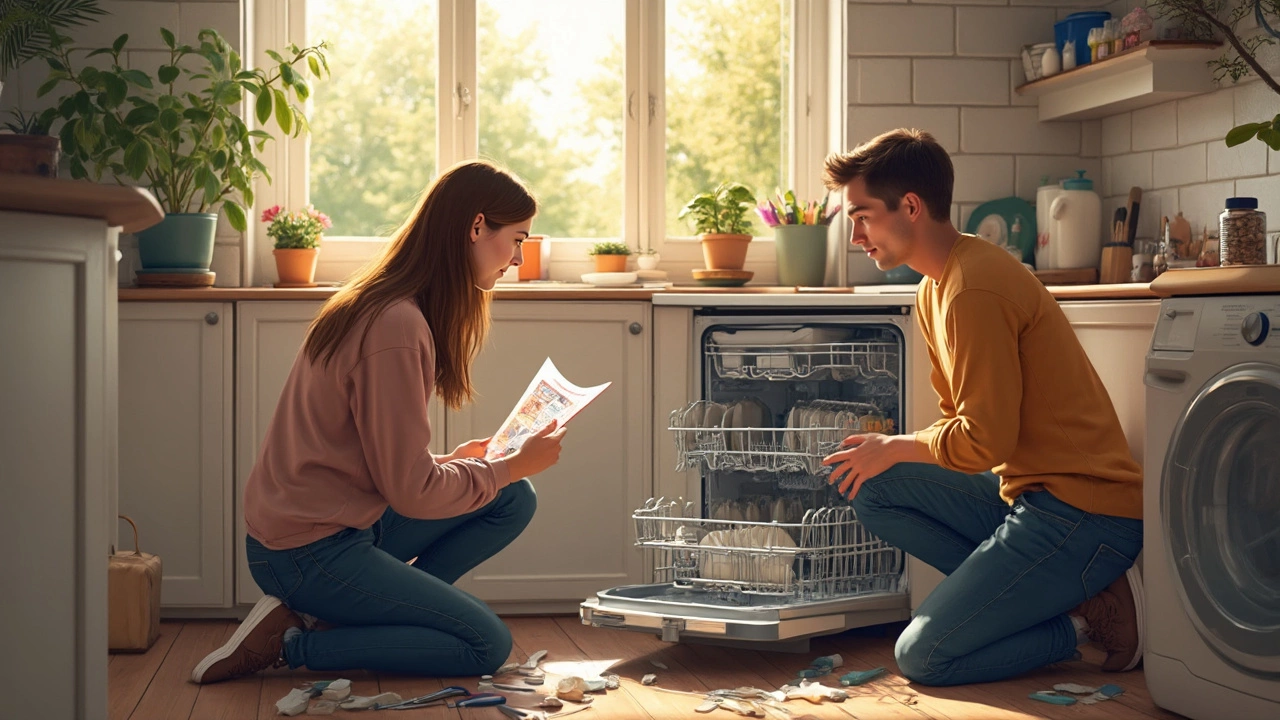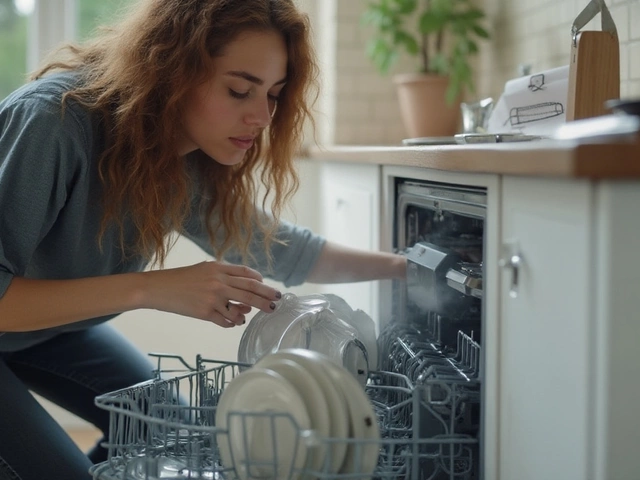Your dishwasher isn’t out to ruin your evening—usually, it’s just trying to get your attention. If it’s not cleaning well, won’t start, or leaves puddles on the floor, you need to figure out why before things get worse. Most dishwasher issues start off simple, like a sneaky clogged filter or a blocked spray arm. Ignoring them? That’s when the real trouble (and costs) show up.
So what’s the first thing you should check? It’s not always the parts inside the machine. Sometimes, something as basic as a tripped breaker, a closed water valve, or the way the dishes are loaded can mess everything up. Start with a quick once-over: check if the dishwasher has power, water is flowing, and the racks aren’t overloaded. These little checks save you time and keep you from ripping into the guts of your appliance for no reason.
- First Signs Your Dishwasher Isn’t Happy
- Check the Basics: Power, Water, and Loading
- Unusual Noises and What They Mean
- Smells, Leaks, and Stains: Troubleshooting Hidden Issues
- Error Codes and Blinking Lights Explained
- DIY or Call a Pro? Knowing When to Get Help
First Signs Your Dishwasher Isn’t Happy
Funny smells. Sudsy puddles on the floor. Plates with dried-on crud even after a full cycle. These signs aren’t just annoying — they’re warnings your dishwasher needs attention. Not sure what to look for? Most dishwashers tip their hand pretty early, but you have to know the clues.
- Dishwasher repair pros often say a bad smell is usually mold, stale water, or food stuck somewhere it shouldn’t be.
- Unusual grinding or buzzing noises can mean something’s stuck against the spray arms, or maybe the motor is struggling.
- If your dishes feel grimy or spotty, the problem could be with water temperature or detergent not dispensing right.
- Leaking water by the door or under the unit often means a door seal problem or a loose hose.
- Running way longer than usual or stopping mid-cycle usually points to sensor, float switch, or control board issues.
Here’s a quick breakdown showing the most common early warning signs and what parts they usually connect to:
| Symptom | Likely Cause |
|---|---|
| Bad odor | Dirty filter, trapped food, clogged drain |
| Noisy cycle | Foreign object, faulty pump, spray arm issue |
| Leaking water | Worn door seal, loose hose, misaligned door |
| Dirty dishes | Faulty spray arm, blocked filter, wrong detergent |
| Cycle stops mid-way | Float issue, control board fault, door latch |
Don’t let these signs slide just because your dishwasher still runs. Fixing something early—like replacing a $15 seal—beats waiting until water pours all over your kitchen floor. The sooner you spot a problem, the easier (and cheaper) it is to fix.
Check the Basics: Power, Water, and Loading
Before digging into the guts of your dishwasher, check the basics—because a surprising chunk of dishwasher repair calls come down to simple stuff. Sometimes the fix is so basic it’s almost embarrassing.
Start with power. If the dishwasher won’t start, it might not be getting electricity at all. Check the breaker box to see if the switch tripped. Try pressing the reset button if your model has one. You’d be shocked how often someone finds they just bumped the on/off switch under the sink or unplugged the machine moving stuff around. Make sure the outlet works by plugging in something else, like a hairdryer.
Next up, water supply. If there’s no water, or the dishwasher fills super slow, check that the water shutoff valve under your sink is open. Sometimes, it gets closed during plumbing work or if someone’s cleaning under there. Kinked hoses happen too—pull the dishwasher out a little and peek behind it. And if your household water pressure drops, your dishwasher probably won’t run right.
Loading might seem basic, but it messes with cleaning big time. Stacking plates or bowls in all the wrong places blocks water spray arms. Cups upside down over the jets? Total rinse disaster. Here’s a quick reference chart that professional techs use for basic diagnosis:
| Problem | Likely Basic Cause | Quick Fix |
|---|---|---|
| Won’t start | No power or door not closed properly | Check power, breaker, and latch |
| Not filling | Closed water valve or kinked hose | Open valve, check hose |
| Dishes dirty | Poor loading or blocked spray arms | Adjust loading, clear arms |
If you fix these basics and the dishwasher still acts up, then it’s time to dig a bit deeper. But don’t skip this step—it really does solve a ton of problems for folks.
Unusual Noises and What They Mean
Dishwashers aren't exactly silent, but not every sound is normal. If you're hearing rattles, humming, or grinding, your machine is basically waving a red flag. Pinning down the noise can help you fix it before a small problem becomes a breakdown.
Here’s a cheat sheet for common dishwasher noises and what they usually mean:
- Grinding: This often means food debris is stuck in the chopper blade or pump. Some machines have self-cleaning filters that can get blocked up. If the sound keeps coming back, check the filter and clear out any leftover debris.
- Rattling: Loose utensils or dishes bumping against each other are a top culprit. Make sure nothing is sticking down past the bottom rack, and see if spray arms can spin freely.
- Humming: A low hum is okay—it's the motor. But if it’s loud and nothing is happening (no water moving, no washing), the pump might be stuck on something or failing. Unplug it and try spinning the pump by hand if you’re comfortable.
- High-pitched squealing: Usually means a worn out or dry dishwasher motor bearing. Sometimes, a little lubrication fixes it, but most of the time, it may be the beginning of the end for the motor.
- Clicking or popping: Most models make a click at the start or end of a cycle. Constant clicking, though, usually means a problem with a relay or door latch.
It’s wild, but about 40% of dishwasher repair calls are actually about odd noises that turn out to be harmless—like a fork slipped down and got caught. Sometimes, you can solve it by just rearranging the dishes.
| Noise | Likely Cause | Quick Fix |
|---|---|---|
| Grinding | Debris in pump/filter | Check and clean filter, remove debris |
| Rattling | Loose dishes/utensils | Secure loaded items |
| Humming | Stuck pump, bad motor | Inspect pump; call a pro if stuck |
| Squealing | Bad motor bearings | Lubricate if possible, may need replacement |
| Clicking/Popping | Normal cycle, relay or latch issue | Observe pattern, fix latch if faulty |
If the noise is new and persistent, don’t just turn up the TV to drown it out. Catching it early can save you from a bigger, pricier repair down the line.

Smells, Leaks, and Stains: Troubleshooting Hidden Issues
Let’s face it: a funky-smelling dishwasher is just plain gross. If you open the door and get a whiff of something foul, there’s usually leftover food gunk somewhere inside. Food bits can pile up in the filter, spray arms, or even weird corners you didn’t know existed. Mold and bacteria love warm, wet spots—so run a cleaning cycle every month, and always take out chunks of food before loading your plates. A simple trick? Sprinkle a cup of baking soda on the bottom and run a hot rinse. It works like magic for most odors.
Leaking water is another headache. About 20% of dishwasher service calls in 2024 were for leaks. The first spot to check is right at the door seal—a worn or cracked gasket almost always means drips on the floor. Look for obvious damage or mold around the seal. Next, examine the hoses under the sink; even a tiny looseness can cause steady leaks. And don’t ignore clogged spray arms or a backed-up drain, since water can overflow right onto your kitchen floor.
Stains—especially white, chalky ones—are usually caused by hard water. Limescale coats the inside of the machine, racks, and even your glasses. If you notice glassware coming out with spots, try adding a rinse aid and check your water hardness level. A quick look at this table can help you figure out what your stains are telling you:
| Stain/Smell Type | Possible Cause | Quick Fix |
|---|---|---|
| Musty/Moldy Odor | Trapped food, mold near door seal | Run cleaning cycle, scrub seal |
| Yellow/Brown Stains | Iron in water or rusting parts | Check for rusty racks/parts, use dishwasher cleaner |
| White Chalky Residue | Hard water limescale | Add rinse aid, use citric acid cleaner |
| Leaks under door | Worn gasket or poor alignment | Replace gasket, check latch |
| Swampy odor during cycles | Clogged filter/drain | Clean filter and drain area |
If you see weird colors or persistent stains, it could point to bigger problems—like a failing heating element or a corroding interior. These aren’t jobs for guesswork. When in doubt, take a photo of the problem and search your dishwasher repair model online. People share tons of real-life fixes for stuff like this every day.
One last thing: never let standing water sit in your machine. It’s a breeding ground for bacteria, and a sign that something’s wrong with the drain. Always pull the plug, scoop out the water, and check the filter first. Most hidden issues are just a few practical checks away from being solved for good.
Error Codes and Blinking Lights Explained
Those mysterious blinking lights and error codes on your dishwasher aren’t just for show. They’re the machine’s way of telling you what’s wrong—pretty much like a car’s check engine light. Ignoring them could turn a simple fix into a headache. Different brands have their own codes, so you’ll want to peek at your owner’s manual or check the manufacturer’s website for the exact meaning. But some codes and blinks show up often and usually point to the same culprits.
Here’s a quick rundown of the most common error codes and what they usually mean:
| Error Code | Brand Example | Common Cause |
|---|---|---|
| E24 | Bosch | Drain blocked |
| F2 | Whirlpool | Water leakage |
| CE | LG | Communication error (control board issue) |
| HE | Samsung | Heater issue |
| OE | LG | Drain error |
Blinking lights? Brands like GE and KitchenAid often use a sequence of blinks to signal issues. For example, a “Normal” light blinking seven times on a GE dishwasher means a heating problem. It’s not random—the pattern is the clue. If you see lights flashing rapidly or in a steady pattern, count the blinks. Look up the pattern—it could save you hours of wild guesses.
“Error codes take the guesswork out of diagnosing appliance problems. Instead of poking around, you know exactly where to start,” says technician Mike McGregor from Appliance Tech Today.
Here’s how you can handle error codes and blinking lights like a pro:
- Write down exactly what the error says (letters, numbers, or the blink pattern).
- Unplug the dishwasher for a minute and plug it back in—sometimes, the code resets.
- Look up the code in the manual or online for your exact model.
- Check the obvious. If it says “drain error,” check the filter and hose for clogs.
- If resetting doesn’t work and you see the same code again, you might need a part replaced or a service call.
Dishwasher manufacturers say error codes are now the top reason owners can speed up repairs themselves—almost 40% of "simple fixes" are sorted after reading the code and looking up what it means. So, next time you see those blinking lights, don’t just stand there guessing. Decode it, act, and get back to having clean dishes without the drama.
The main takeaway? Never ignore or cover up that code with tape. It’s your *dishwasher repair* shortcut, not something to hide from.
DIY or Call a Pro? Knowing When to Get Help
Sometimes, fixing your dishwasher is easy—think unclogging the filter or rearranging the dishes so water can reach all the grime. But not every problem is a quick fix with a screwdriver and a YouTube video. Knowing when to roll up your sleeves and when to call in backup can save you cash and headaches.
Here’s a rundown of typical issues you can tackle yourself, plus the ones that scream for a pro. Start simple. If your dishes aren't coming out clean, check the spray arms for clogs, clear debris from the filter, or use a dishwasher cleaner to bust some built-up gunk. For basic leaks, tightening a hose or replacing a worn door gasket is usually within reach.
- Dishwasher repair jobs like changing out the detergent dispenser, unclogging drains, or swapping out racks are doable for most folks with basic tools.
- Anything involving electrical wiring, control panels, or the main pump (like grinding noises or the dishwasher refusing to start at all) means you’re better off calling in someone certified.
One stat worth knowing: a recent home repair survey showed that DIY fixes solve about 60% of dishwasher clogs or drainage problems, while motor or circuit board failures almost always require a professional.
| Problem Type | DIY | Call a Pro |
|---|---|---|
| Clogged Filter | ✔️ | |
| Leaking Door Seal | ✔️ | |
| Strange Noise (Light Rattling) | ✔️ | |
| No Power / Dead Control Panel | ✔️ | |
| Pump/Motor Problem | ✔️ | |
| Error Codes Blinking | Sometimes | ✔️ if unsure |
The golden rule: If the fix means taking apart more than you feel comfortable with, or you catch a whiff of burnt wiring, don’t mess around. Call a pro before a small problem becomes a full-on kitchen flood or a safety risk. And when in doubt, get an estimate. Most repair shops are used to quick phone calls about symptoms and can tell you right away if it’s an easy fix or a job for an expert.




